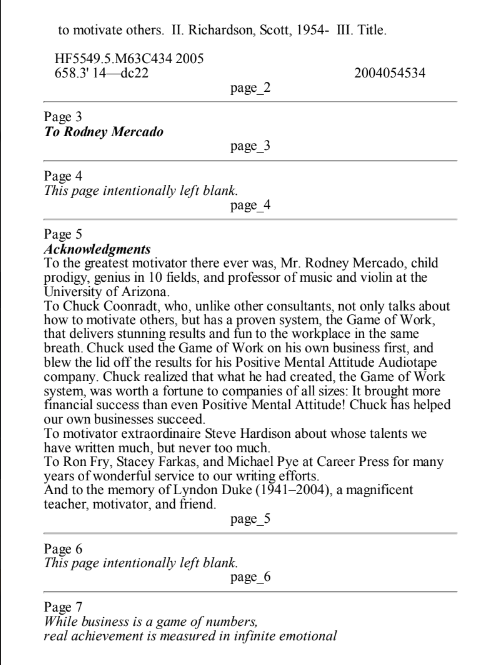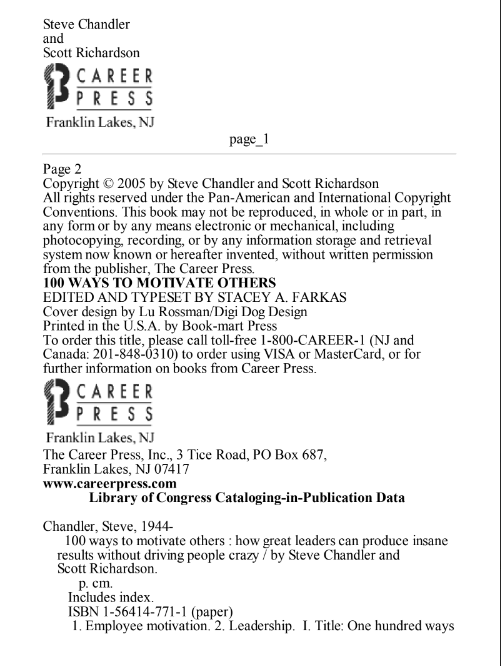


If you were an American transferred to Juarez to live for a year and needed to make your living there, the more Spanish you used, the better it would be for you. If you had never used Spanish before, you could still use it. You can open your little English/Spanish phrases dictionary and start using it. You can ask for directions or help right out of that little dictionary! You didn’t need to have been born with anything special. The same is true with self-discipline, in the same exact way. Yet most people don’t believe that. Most people think they either have it or they don’t. Most people think it’s a character trait or a permanent aspect of their personality. That’s a profound mistake. That’s a mistake that can ruin a life. But the good news is that it is never too late to correct that mistake in yourself and your people. It’s never too late to learn the real truth. Page 12 And listen to how people get this so wrong: “He would be my top salesperson if he had any self-discipline at all,” a company leader recently said. “But he has none.” Not true. He has as much self-discipline as anyone else does, he just hasn’t chosen to use it yet.
Just as we all have as many Spanish words to draw upon as anyone else. It is true that the more often I choose to go to my little dictionary and use the words, the easier it gets to use Spanish. If I go enough times to the book, and practice enough words and phrases, it gets so easy to speak Spanish that it seems like it’s part of my nature, like it’s something I “have” inside me. Just like golf looks like it comes naturally to Tiger Woods. Self-discipline is the same. If the person you lead truly understood that self-discipline is something one uses, not something one has, then that person could use it to accomplish virtually any goal he or she ever set. They could use it whenever they wanted, or leave it behind whenever they wanted. Instead, they worry. They worry about whether they’ve got what it takes. Whether it’s “in” them. Whether their parents and guardians put it there. (Some think it’s put there experientially; some think it’s put there genetically). It’s neither. It’s never put “in” there at all. It’s a tool that anyone can use. Like a hammer. Like a dictionary.) Enlightened leaders get more out of their people because they know that each of their people already has everything it takes to be successful.
They don’t buy the excuses, the apologies, the sad fatalism that most non-performers skillfully sell to their managers. They just don’t buy it. George S. Patton. You can’t motivate someone who can’t hear you. If what you’re saying is bouncing off their psychological armor, it makes little difference how good you are at saying it. You are not being heard. Your people have to hear you to be moved by you. In order for someone to hear you, she must first be heard. It doesn’t work the other way around. It doesn’t work when you always go first. Because your employee must first appreciate that you are on her wavelength and understand her thinking completely. As leadership guru Warren Bennis has said, “The first rule in any kind of coaching is that the coach has to engage in deep listening. Which means that the coach must relate to the context in which the ‘other’ is reasoning—they must ‘tune in’ to where the other is coming from.
In short, perhaps the basis of leadership is the capacity of the leader to change the mind-set, the framework of the other. That’s not easy, as I needn’t tell you for most of us, thinking that we have tuned in to the other person, usually are listening most intently to ourselves.” We were working with a financial services CEO named Lance who had difficulties with his four-woman major account team. They didn’t care for him and didn’t trust him.
Page 2, Because I don’t have too much to do. The truth is, **there is only one** **thing to do**, and that is the one thing I have chosen to do right now. If I do that one thing as if it’s all I have to think about, it will be extremely well done and my relationship with any other person involved will be better and more relaxed and full of trust than before. A careful study of my past week shows me that I did a lot of things last week and they all got done one thing at a time. In fact, even in my busiest time ever, I was only able to do one thing at a time, even though I stressed myself and other people out by always thinking of seven things at once…so when I talked to you all I could think about was the seven other people I needed to talk to…so eventually all seven people felt that stress and that lack of attentiveness…that absolute lack of warmth.
Doing more than one thing at a time produces fear, adrenaline, and anxiety in the human system and people pick up on that. People are not drawn to that. They keep away from that. The mind entertains one thought at a time, and only one. The greatest cause of feeling “swamped” and “overwhelmed” in life is caused by not knowing this. I need to choose from the list of things that need to be done, and then do the one thing as if that were the only thing. If it’s a phone call, then I need to slow down and relax and let myself be in a good mood so that the phone call will be a good experience, and the recipient and I can be complete afterward. We talked to Jason last week, a national sales manager who had just finished a brutal, long phone conference with his team. He spent the conference call nervously urging his team on to higher numbers and warning them that the team goals were not going to be met at the rate they were going. He had called the meeting because his own superiors had just called him to question him about his team’s poor performance. Although Jason had been working 12-hour days, he felt he was falling behind in everything.
On top of that, his superiors’ anxiety was then passed down to him. Because it was passed down into a hectic, disorganized mind, he freaked out and took it out on his team. This is not motivation. Motivation requires a calm, centered leader, focused on one thing, and only one thing.


